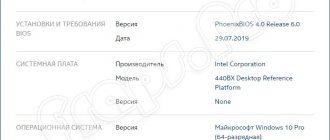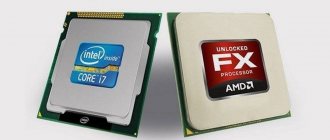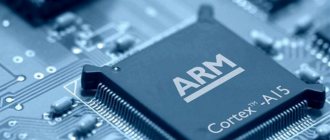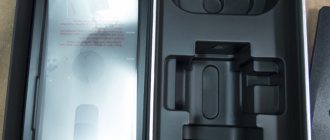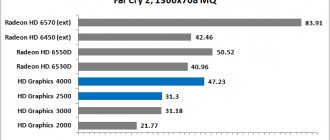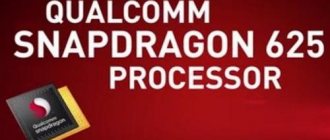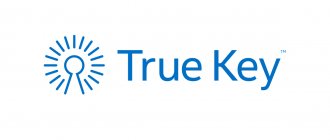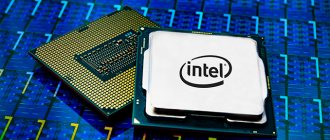Architecture
Intel Atom is a CISC processor with x86 architecture. Intel Atom can execute up to two instructions per clock cycle (through the use of u- and v-pipelines).
Generations
- Intel Bonnell (45 nm; 2011-2013)
- Intel Saltwell (32 nm; 2012-2013)
- Intel Silvermont (22 nm; since 2013)
- Intel Cherry Trail (14 nm; from 2020)
Performance
It is widely believed that the performance of a single-core Atom processor is approximately half that of an equivalent Pentium M. For example, the 1.6-GHz Atom used in many modern netbooks (Asus Eee PC, etc.) provides performance of 3300 MIPS and 2.1 GFLOPS in standard tests[2] against 7400 MIPS and 3.9 GFLOPS of the Pentium M 740 (1.73 GHz)[3].
It has been published that a system based on a dual-core Atom N330 and a system based on a dual-core Core Duo 2300 (1.66 GHz) are similar in performance.[4] Although, for example, the results of a more authoritative study say that the speed of the Atom 330 is comparable only to the Intel Celeron M 520.[5]
Application
There is an opinion that, having two virtual cores, the CISC architecture is less suitable for implementing mobile device processors (where these processors are mainly used) than RISC (for example, ARM processors based on the RISC architecture are widely used in modern mobile devices). [6]
Currently, the Atom platform has low enough power consumption for use in smartphones and tablets, and even lower in comparison with similar ARM processors competing in this segment of mobile electronics. And the lower popularity of SoCs on the Atom platform is dictated not by power consumption and price, but by the low adaptability of the software to the x86 architecture.
Test results
We used our old, tested Linux-Bench scripts. We have a more recent selection of scripts, but in this case it seemed not so necessary, since the main purpose of this platform is built-in applications. When using a similar configuration in data warehouses or network devices, embedded applications do not have a high load, and the use of extended AVX2 and AVX-512 command sets seems unnecessary.
In our past tests, we were convinced that the best OS for Intel Atom C2000 series processors are Linux and FreeBSD. Windows is not widely used on such platforms, and we do not recommend using this platform as a regular computer. There are plenty of other, more advantageous options for this.
Python Linux 4.4.2 Kernel Compile Benchmark
We use this test often. A standard configuration file is used, the Linux kernel 4.4.2 taken from kernel.org, and the standard generated configuration loads every thread in the system. The results show the number of compilations per hour.
The results obtained showed very good performance, which is comparable to the results of the 8-core Xeon D processor. The C3955 model showed slightly better results. This is not surprising; nevertheless, differences in microarchitecture should manifest themselves in the operation of processors.
c-ray 1.1
Another ray tracing test we constantly use, it is very popular and shows the difference in performance in multi-threaded systems.
The performance shown is good here too. As expected, the more “nimble” and even turbocharged C3955 showed better results. Interestingly, the Intel Xeon E3 showed similar performance, but it does not have many of the features that the Atom has, and it also consumes more power.
7-zip Compression
A very popular and frequently used cross-platform application for archiving/unzipping data.
The results obtained are very good. Of course, 16 Atom cores are not 16 Xeon D cores, and you won’t be able to compete with the latter. In this case, QAT is not used, and this could significantly change the results, as we will see shortly. If we talk about performance, then in terms of compression speed, the Intel Atom C3958 can be placed somewhere between 6 and 8-core Xeon D. Decompression speed is somewhere between 8 and 12-core Xeon D.
Sysbench CPU test
Another popular test on the Linux platform. We used the CPU test, and not the OLTP test, which is used when testing drives.
We had to remove the results from the C2358 and D525 processors due to the low values, which would have made the graph difficult to read. The test scales well and perfectly loads all available processor cores. It is not surprising that 16 cores came very well.
OpenSSL
A cryptographic package used to encrypt communications between servers. We got the following result.
When we checked again, we got the following (we sorted the results in the same order as in the first test run to make it more convenient).
As we can see, the Intel Atom C3958 competes with the similarly priced Xeon Silver 4108, which is designed for more powerful servers. But more interesting in this case is the comparison with the previous 2000 generation of Atom processors. The top-end C2758 with QAT enabled turned out to be 4 times slower than the C3958, which did not use this function. This is important because OpenSSL is often used in network devices and storage systems.
UnixBench Dhrystone 2 and Whetstone Benchmarks
The tests are old, but for now we continue to use them due to popular demand. UnixBench Dhrystone 2 results.
Whetstone Benchmarks results.
In this case, we see a clear benefit from multi-cores, since in this case it compensates for the compromises in the microarchitecture that had to be made to reduce power consumption. In this case, the option is “by number, not by skill.”
Atom processors
The Intel® Atom™ processor nomenclature is a three-digit numeric sequence with a one-letter prefix. Netbook processors have an N prefix, while the Z prefix indicates that the processor is intended for MID devices.
| Intel Atom processors | |||||||||
| Series | Processors series | technical process, | Cores | Integrated Graphics | FSB, MHz | Core frequency, GHz | L2 cache, KB | Depth, bits | TDP (max), W |
| Mobile Internet Device (MID)/Ultra Mobile PC | |||||||||
| Z5xx (Silverthorne) | Z500, Z510P, Z510PT, Z515, Z520, Z520PT, Z530, Z530P, Z540, Z550, Z560 | 45 | 1 | No | 400…533 | 0,800…2,13 | 512 | 32 | 0,65…2,5 |
| Z6xx (Lincroft) | Z625, Z670 | 45 | 1 | GMA 600 | 400…533 | 1,50 | 512 | 32 | 1…2,2 |
| Z2xx (Saltwell) | Z200 | 32 | 1,2 | PowerVR SGX 540, 545, 544 | — | 1,2-2 | 512 | 32 | — |
| Z3xx (Silvermont) | Z300 | 22 | 4 | Intel Gen 7 | — | 2,1-2,4 | 1024-2048 | 32-64 | — |
| Z4xx (Airmont) | Z400 | 14 | 4 | Intel Gen 8 | — | 2,7 | — | 32-64 | — |
| Z5xx (Goldmont) | Z500 | 14 | 4 | Intel Gen 9 | — | — | — | 32-64 | — |
| Netbook/Nettop | |||||||||
| 2xx (Diamondville) | 230 | 45 | 1 | No | 533 | 1,60 | 512 | 64 | 4 |
| 3xx (Diamondville) | 330 | 45 | 2 | No | 533 | 1,60 | 1024 | 64 | 8 |
| N2xx (Diamondville) | N270, N280 | 45 | 1 | No | 533…667 | 1,60…1,66 | 512 | 32 | 2,5 |
| D4xx (Pine Trail-D) | D410, D425 | 45 | 1 | GMA 3150 | DMI 2.5GT/s | 1,66…1,80 | 512 | 64 | 10 |
| N4xx (Pine Trail-M) | N435, N450, N455, N470, N475 | 45 | 1 | GMA 3150 | DMI 2.5GT/s | 1,33…1,83 | 512 | 64 | 5-6,5 |
| D5xx (Pine Trail-D) | D510, D525 | 45 | 2 | GMA 3150 | DMI 2.5GT/s | 1,66…1,80 | 1024 | 64 | 13 |
| N5xx (Pine Trail-M) | N550, N570 | 45 | 2 | GMA 3150 | DMI 2.5GT/s | 1,5…1,66 | 1024 | 64 | 8,5 |
| E6xx | E620, E620T, E640, E640T, E660, E660T, E680, E680T | 45 | 1 | GMA 600 | DMI 2.5GT/s | 0,6…1,6 | 512 | 32 | 3,3…4,5 |
| D2xxx (Cedarview-D) | D2500, D2550, D2700 | 32 | 2 | GMA 3600/3650 | DMI 2.5GT/s | 1,87…2,13 | 1024 | 64 | 10 |
| N2xxx (Cedarview-M) | N2600, N2800 | 32 | 2-4 | GMA 3600/3650 | DMI 2.5GT/s | 1,60…1,87 | 1024 | 64 | 3,5…6,5 |
| (Valleyview) | not announced | 22 | 1-4 | Intel Gen7 | DMI 2.5GT/s | 1,20…2,40 | 2048 | 64 | 3,5…6,5 |
Choosing a tablet with an Intel Atom processor
Intel entered the processor market for mobile devices far from being at the forefront, but despite this, it found its niche in it. Intel Atom processors today can be found in tablets from companies such as ASUS, Dell, Samsung, mainly in models in the mid-price segment. Traditionally for Android “tablets” of noble origin, “atom” devices are available in sizes 7, 8 and 10 inches. In this material we will dwell in detail on the 10-inch and 7-inch segments. We will talk about the “large” models ASUS Memo Pad FHD 10 and Samsung Galaxy Tab 3 10.1 and the “small” ones - Dell Venue 7, two ASUS Fonepad 7 and ASUS MeMO Pad 7. In this material we will try to figure out why you need to buy a tablet for Intel Atom (if you really need it) and which model to choose from the existing range.
Specifications
In terms of performance and such a more obvious parameter for the user as the smoothness of the interface, Intel Atom owners are superior to budget competitors on all sorts of Mediatek, RockChip, Alwinner and demonstrate approximately the same operating speed that will satisfy most users. Most of the models discussed in the material have a dual-core Intel Atom Z2560 (Clove Trail+), and the new ASUS MeMO Pad 7 (ME176C) has the latest Bay Trail platform with a quad-core Intel Atom Z3745 chipset. Since the model was just released, it is the only one running Android 4.4 KitKat, while the rest use JellyBean. All models, except ASUS MeMO Pad FHD 10 with FullHD, use a matrix with HD display resolution, which is quite enough for a 7-inch, but may not be enough (it all depends on the user’s perception, for example, it seems to me not enough) for some of people.
| Specifications | |||||
| Model | ASUS MeMO Pad FHD 10 | Samsung Galaxy Tab 3 10.1 | ASUS MeMO Pad 7 | Dell Venue 7 | ASUS Fonepad ME175CG / ME372CG |
| Android version | 4.2 | 4.2 | 4.4 | 4.3 | 4.3 |
| Dimensions and weight | 265x182x10 mm and 580 g | 241x176x8 mm and 510 g | 192x110x11 mm and 295 g | 193x118x10 mm and 234 g | 192x110x11 mm and 290 g |
| Display | IPS, 10.1 inches, FullHD, pixel density 226 ppi | TFT, 10.1 inches, HD, pixel density 149 ppi | IPS, 7 inches, HD, pixel density 216 ppi | IPS, 7 inches, HD, pixel density 216 ppi | IPS, 7 inches, HD, pixel density 216 ppi |
| CPU | Intel Atom Z2560, 1.6 GHz, 2 cores | Intel Atom Z2560, 1.6 GHz, 2 cores | Intel Atom Z3745, 1.86 GHz, 4 cores | Intel Atom Z2560, 1.6 GHz, 2 cores | Intel Atom Z2520, 1.2 GHz, 2 cores / Intel Atom Z2560, 1.6 GHz, 2 cores |
| Graphic arts | PowerVR SGX544MP2 | PowerVR SGX544MP2 | Intel HD Graphics for Bay Trail | PowerVR SGX544MP2 | PowerVR SGX544MP2 |
| RAM | 2 GB | 1 GB | 1 GB | 2 GB | 1 GB |
| Storage device | 16/32 GB | 16/32 GB | 8/16 GB | 16 GB | 8/16 GB |
| Camera | 5 MP, FullHD video recording, front 1.3 MP | 3 MP, HD video recording, front 1.3 MP | 5 MP, FullHD video recording, front 2 MP | 3 MP, HD video recording, front VGA | 3 MP, HD video recording, front 1.3 MP/MP, HD video recording, front VGA |
| Communications | Wi-Fi 802.11 a/b/g/n, Bluetooth 3.0 | Wi-Fi 802.11 a/b/g/n, Bluetooth 4.0, IR port | Wi-Fi 802.11 a/b/g/n, Bluetooth 4.0 | Wi-Fi 802.11 a/b/g/n, Bluetooth 4.0 | Wi-Fi 802.11 a/b/g/n, Bluetooth 4.0 |
| Battery | 6760 mAh | 6800 mAh | n.d. | 4100 mAh | 3950 mAh |
10-inch: ASUS MeMO Pad FHD 10 vs Samsung Galaxy Tab 3 10.1
For both 10-inch models they ask for almost the same money: both the Asus product and the Samsung product can be purchased with a little more than 3,500 UAH in your pocket. The models use the Z2560 chipset with a clock frequency of 1.6 GHz, and the difference is the amount of RAM and display resolution. MeMO Pad FHD 10 has 2 GB of RAM, which is justified by the presence of a FullHD screen. Samsung Galaxy Tab 3 10.1, although it was the crown of evolution of the Tab line at the time of release, only received an HD screen (in total, we have a pixel density of the Asus screen of 226 ppi versus 149 ppi in Samsung). And it has 1 GB of RAM.
Samsung Galaxy Tab 3 10.1 performance:
ASUS MeMO Pad FHD Performance:
In terms of calibration quality, the screens of the two models are approximately the same: both have a color gamut that does not reach the sRGB space, which hints that beautiful pictures and movies on the screen will not look as bright as intended, and the color temperature, although not a reference, is by class standards it is very close to that. However, the Galaxy Tab 3 10.1 has a brighter display, which is visible to the naked eye. It will be more comfortable to watch movies and explore social networks on the street on a fine day (368 cd/m2 versus 297 cd/m2).
Samsung Galaxy Tab 3 10.1 screen:
ASUS MeMO Pad FHD 10 screen:
The battery capacity of both devices is approximately equal - 6800 for Samsung and 6760 for Asus. Depending on the backlight intensity, each model will be able to provide from 5 to 10 hours of video playback, which is not a record today, but cannot be called a disadvantage either.
It would seem that with the same price and difference in characteristics, the Asus MeMO Pad FHD 10 beats its competitor to one another. But there is a nuance. Compare the dimensions of the models and the location of the speakers in the pictures below. Memo Pad FHD 10 is noticeably inferior to its competitor in terms of compactness of the body and slightly in ergonomics - its speaker is located in an awkward place and can easily be closed by hand. The weight difference between the models is 70 g.
The sensations from the smoothness of the interface of the models are the same. The devices work much faster than their colleagues from the more affordable segment, but at the same time they are inferior to flagships, in particular, the Sony Xperia Z2 Tablet, the price of which is twice as high. Both models are capable of beautiful games and great films, and the fact that you don’t have to sit and wait for each action on the device makes you want to sing. The ASUS Memo Pad 10, which is less expensive at about $50 (600 hryvnia), or, for example, tablets with HD resolution from players such as Prestigio, PocketBook, etc., demonstrate a slower interface. If your financial affairs are not completely bad, then increasing the purchase budget by $50 in the 10-inch tablet segment in favor of Intel Atom owners will be justified.
As a result, it can be argued that each of the two models has its own competitive advantages that make their purchase justified. Thanks to its brighter display and compact size, the Samsung Galaxy Tab 3 10.1 will be the best choice for those who plan to often take the tablet with them on trips or simply value compactness more than the clarity of the image on the screen. ASUS MeMO Pad FHD 10 is a “home” device that will please the eye with a high-resolution display and will not eat up valuable centimeters of free space from your bag.
7-inch: Dell Venue 7 vs many ASUS tablets
In the segment of 7-inch Intel Atom tablets, ASUS is most actively represented (despite the fact that the 7-inch hit Nexus 7 also appeared in collaboration with Asus and is a competitor to other 7-inch models) with the MeMO Pad and Fone Pad lines. But we’ll start with the Dell Venue 7 tablet, so as not to get confused by Asus’s right away. The model's characteristics are identical to its 8-inch counterpart. The Dell Venue 7 is equipped with the same Intel Atom Z2560 as the 10-inch tablets. It is interesting because it has as much as 2 GB of RAM and bare Android. All together, this allows the device to demonstrate greater agility in responding to user actions. Performance test results can be seen in the dedicated gallery below. I did not have any problems with installing and launching any applications during the preparation of the review.
In my opinion, the Dell Venue 7 has a better body than its “atomic” competitors: made of soft Soft Touch plastic with metal volume control keys and screen lock. Another good thing about this model’s body is that its ends are not beveled, so it’s more convenient to press the keys than on Asus tablets. In the photographs below you can see the appearance of the tablet. The only thing it lacks is compactness. It is comparable in size to most models, but it frankly falls short of the new ASUS MeMO Pad 7.
Finally, the final argument in favor of choosing this particular model is the lower price with a smoother interface - those who value their time will like this.
Below are measurements of the tablet screen. It does not shine with backlight brightness - 284 cd/m2, which is typical for an inexpensive tablet, and in other respects it is a typical “average” one: slightly cold, with a narrow color gamut, but with excellent viewing angles typical for an IPS matrix. Despite the screen's shortcomings, the Dell Venue 7 is one of the best offers in its price segment.
ASUS MeMO Pad 7 is interesting primarily because it uses the new generation Bay Trail processor - Intel Atom Z3745. This is one of the first models on Android OS and on Bay Trail at the same time (they appeared on Windows 8 at the beginning of the year). For the reader who does not want to delve into the technical nuances, it is enough to know that the Z3745 can expect better performance (four cores clocked at 1.86 GHz) and energy efficiency (22 nm process technology). Indeed, in the AnTuTu test the device demonstrates almost a flagship result, and it also scores an impressive number of points in the 3DMark test. In real life, the tablet interface works quite smoothly, smoother than other models in the line, despite the fact that the model has only 1 GB of RAM and is not the lightest Asus proprietary shell. You can read more about it, for example, in this review. Below are screenshots of benchmarks.
The sample, which is currently at the disposal of the editors, had problems with the battery, so there was no point in conducting autonomy tests on it. Asus writes in the specifications that it will be only an hour less than the new Fonepad model - that is, up to 9 hours of multimedia playback. On our copy, the Vellamo and Epic Citadel tests refused to run and the game Real Racing 3 did not work. But there were no problems with the rest of the usual arsenal for testing and use, I believe that support for these applications will also appear in the near future.
MeMO Pad 7 has the most compact body of all 7-inch “atom” media. In addition, it is narrower and shorter than the Nexus 7. Like the Dell Venue 7, it is covered with a pleasant matte Soft Touch plastic. But the ergonomics of the model’s body suffers due to the frankly strange placement of the volume and screen lock keys. The Asus tablet is superior to the Dell Venue 7 in terms of camera resolution - 5 MP versus 3 MP. Although in the case of tablets this difference is purely nominal.
The tablet screen has average brightness - 262.91 cd/m2. Its color gamut is narrower than sRGB, and color reproduction is accurate in dark areas of the image, but degrades noticeably towards light areas.
The bad news is that if the model costs more than the same Fonepad 7, then in price it will no longer compete with the Venue 7, but with the second generation Nexus 7, which is equipped with a FullHD display, support for all kinds of mobile networks, including and LTE is still irrelevant for Ukraine. The main advantage of Memo Pad 7 over the second-generation Nexus 7 will be performance - the new product can compete with flagships in this parameter, and is the most attractive in its segment. So, ultimately, the user will have to choose between today’s maximum performance and a high-quality screen, support for mobile networks and always up-to-date firmware. A non-trivial problem.
The Fonepad line of tablets consists of budget models, of which there are already several, all of which, thanks to the presence of a communication module, can replace a smartphone. Two 7-inch Fonepad representatives have Intel Atom processors. Fonepad 7 with code ME175СG is equipped with a weaker processor (Z2520 with a clock frequency of 1.2 GHz) and costs the same as the Dell Venue 7. The model with code ME372CG is equipped with the already familiar Z2560 with a clock frequency of 1.6 GHz and costs 500 hryvnia expensive. In benchmarks, of course, the advantage is on the side of the older model, but it is inferior to the Dell Venue 7. Below is a gallery with screenshots of Fonepad 7 ME175СG benchmarks.
And also Fonepad 7 ME372CG.
Visually, the models are very different from each other. The older one received a case with glossy plastic, and two speakers on the front side, which are almost impossible to cover with your hands while playing games or watching videos.
The body of the younger model does not have large speakers, and the back panel has a Soft Touch coating - pleasant to the touch and less slippery. But compared to the Dell Venue 7, both models look uninteresting in their segment.
Bottom line
The Clover Trail+ and Bay Trail generation Intel Atom Android tablets on the market are quite powerful mid-priced models that are definitely worth considering as candidates for purchase if you are not ready to spend money on a flagship device in the case of the 10-inch segment and anyway, if you choose the 7-inch model. Oddly enough, the choice between two “large” tablets based on the Intel Atom 2560 is not as obvious as it might seem after a quick study of the price and characteristics. ASUS MeMO Pad FHD 10 is worth choosing if you plan to use the device primarily in “sofa” mode and want a high-resolution screen. The Samsung Galaxy Tab 3 10.1 is worth choosing if you plan to travel a lot with the tablet and, perhaps, actively use it outdoors, because the model has more attractive dimensions and screen brightness for these purposes.
In the 7-inch tablet segment, there are significantly more Intel Atom owners thanks to the efforts of ASUS. If you're looking for an affordable 7-inch tablet, check out the Dell Venue 7, which offers an excellent combination of price and performance, as well as a charismatic design. If your choice of a compact tablet is planned for the future in one quarter, or even more, then wait for the brand new ASUS MeMO Pad 7 on Bay Trail. The tablet has excellent performance, a compact body and the latest version of Android.
Overall, tablets powered by Intel Atom processors are now a great alternative to devices powered by budget ARM processors: they offer better performance than the Snapdragon 400, and at the same time inspire more confidence than MediaTek, Rockchip or, say, Allwinner. There are practically no problems with application compatibility today; We should not forget that work on optimizing Android for Intel architecture is ongoing, which again has a positive effect on performance and compatibility. An important point is the price, which for tablets with Atom today is very attractive, especially when it comes to devices from large manufacturers - such as ASUS, Dell or Samsung.
Notes
- Intel to unveil OLPC chips in Shanghai next April. InfoWorld (October 15, 2007). Retrieved August 31, 2009. Archived March 11, 2012.
- Atom Benchmarked: 4W Of Performance
- Intel Pentium M 740 1.73GHz socket 479 Processor Review
- ZOTAC IONITX-AU Atom N330 WiFi N Motherboard Kit “the dual-core Atom 330 is equivalent to Intel's Core Duo processor.”
- Test of economical systems: Core 2 Duo versus dual-core Atom 330 | THG.RU
- Return of the Son of Pentium in 2008? Intel's new ultramobile processors. ??? (December 12, 2007). Retrieved August 31, 2009. Archived March 11, 2012.
